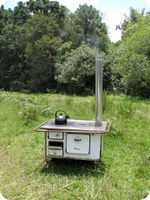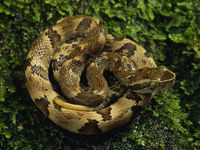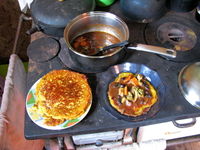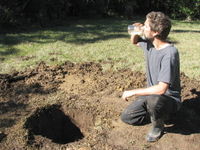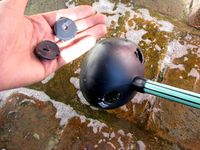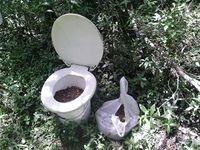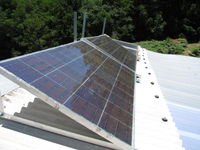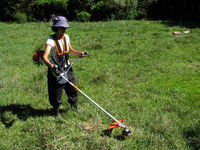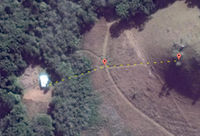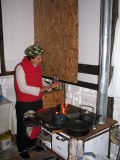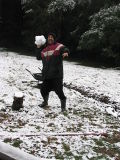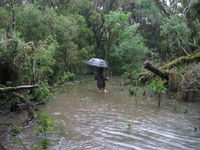Guide to retreat on our land
| 1. Moving from Curitiba to Canela | Our power project | |
| 2. Moving on to our land | Our rural net connection | |
| Year on the land: 1 | 2 | 3 | 4 | 5 | 6 | Our first house | |
| Our second house | ||
| Lada Niva |
Sometimes we leave the land for long periods of time and we'd like to make it available for people to do meditation retreat there while we're away. It's really difficult to find places that are comfortable to live but have practically no distractions. This article is intended to become a guide for living at our place since it's off-grid and has various aspects that will be unfamiliar to those used to normal residential living. See also our daily schedule which may be useful for creating your own schedule for retreat at the land.
This article will cover everything you need to know, but it's recommended to spend a week at the land while we're still there so we can show you these details first hand and introduce you to the neighbours, in case you need to contact them in emergencies, buy some milk, cheese or eggs, or just to have a rest from the intense silence :-)
Contents
Wild life
The only dangerous wild life on the land are snakes, scorpians and some types of spiders, and of these, only snakes are of real concern. All the animals on our land are our friends and as such you must take care not to upset or harm them. There are many different types of snakes (we've seen seven different species so far) and of these a few kinds are very poisonous, but they have a very reclusive and tranquil attitude, so as long as you remain aware not to step in places where you can't see the ground, or to step carefully where you have to be in long grass or foliage, your encounters will be peaceful ones.
For scorpians and spiders just make the habit of keeping your shoes inside at night and shaking them before putting them on, and use the clear plastic pot and cardboard by the 20L water bottle to remove bugs without harming them. Keep the netting door closed at all times to minimise the number of bugs that do enter.
The huge Matukas (horse flies) are an exception to the no-killing rule, in the summer many of them can swarm around you and they painfully inject you with a needle and suck your blood. Brushing them aside or even hitting them will not deter them, as long as they're alive they will cling onto you and inject you!
Mice can be a big problem, but as long as you keep the place clean, keep the compost well covered and inaccessible, and keep the area around the house tidy and clear so there's nowhere form them to make hidden nests, then the they'll prefer to stay amongst the ferns and in the forest and won't be a problem.
Food
Hopefully by the time the first person comes here for retreat (when we go to New Zealand in February 2016) the vegetable garden will be able to provide a good portion of the food. But even then a trip to Canela will be required every month or two to purchase out-of-season vegetables, dry goods like rice and pasta, granola, gas, coal and various other things that the land doesn't provide.
The best way to get to Canela is to walk the path to the bus stop at Vaca Velha in the morning and return by the same route in the afternoon. There's a bus to Canela every Tuesday, Friday and Saturday arrives passing Vaca Velha at 9am. Buses leave from Canela going to Vaca Velha on Monday, Tuesday and Friday at 3:45pm and on Saturdays at 2pm. It's a good idea to call the day before to ensure that the times haven't changed and that the road is damaged - this happens a few times a year unfortunately leaving the buses out of commission for a few weeks sometimes.
If you don't have a fully vegan diet, you can buy eggs, cheese and milk from the neighbours some times, they're only a twenty minute walk away.
See also our article Meals on the land which may give you some useful ideas for cooking with the limited variety of ingredients available in our situation.
- Storing vegetables and fruit
- an average shopping list
Water
- we use river or rain water for washing (fill the 5L bottles from tank or river to keep an in-house supply each day), well or spring for drinking
- using the well
- Maneco's spring
- the rain water not ok to drink as half the roof is asbestos and is also not clean, it's just for washing and watering the plants
- in absolute emergency (e.g. the well is dry and Maneco's spring isn't working) you can use the river water, but you should boil it first
- to boil water, use the fire not gas as you should do a whole 20L bottle. Best to use one that's already got at least a couple of litres in it so that the newly added boiling water mixes with cold water to avoid boiling water affecting the plastic. Use the cast iron kettle for boiling water on the fire, the blue kettle is for gas. The cast iron kettle should be washed first as rust builds up inside it.
- collecting rain water for the plants in dry season
Washing
Dishes: We have no running water, so washing dishes is similar to how it's usually done when camping. You have two bowls, one for washing, one for rinsing. When the washing water is too dirty, pour into the compost bucket and switch the bowl positions so the rinsing one is the new washing one, then clean the empty bowl and fill it with fresh water for rinsing. I usually have the washing bowl at the front of the bench and rinsing behind it. The dirty water is poured into a bucket below the bench which has a mesh over the top to catch the pieces of food waste. The dirty water is emptied onto the garden beds and the contents of the mesh emptied into the main compost barrel in the garden along with the small purple compost bin under the bench. The mesh and dirty water bucket should be cleaned every week or so as it can start to smell. Be sure to replace the cover of the compost barrel after emptying the food waste into it so that mice can't enter it.
- clothes, fill two large black buckets, one for washing, one for rinsing, use rain water from the tank if sufficient, otherwise collect from the river with buckets and wheelbarrow. Use the gambiarra tool made from a toilet plunger (shown in photo to the right) to make washing easier. Twisting the clothes to squeeze the water out is hard work, especially for blankets and sheets, we usually use the spinner with the generator. The spinner often wobbles, don't let it keep running when it wobbling, stop it and adjust the contents or take some things out if it won't stop wobbling.
- self - we use the river most of the time, but when it's really cold we wait until the house is warm in the evening from the fire and then fill the purple bowl with water (you can even add some hot water) and wash with a flannel.
Toilet
We use a dry toilet which means dry material is added after use, our first version was just a bucket with a toilet seat on top of it, and we used saw dust as the material to add. The dry material absorbs all the odour and helps the composting process occur much more efficiently. Our latest version is in a small room made behind the house, we were actually quite content with version one in the forest, but Beth's parents weren't too happy so I built the small cubicle room we have now before they came to visit. Also we now use dry grass clippings instead of saw dust which we needed to source from elsewhere. The best grass is short grass that comes from trimming the lawn around the house, raking it into wide shallow piles and leaving them to dry for a couple of hot days before storing in sacks behind the house. Ensure the sacks have wood on top so that mice don't make nests in them.
- pee in the garden, either water down and pour on veges, or just pee around the ferns, but do in a different place each time to avoid odour
- dry toilet empty in one composter until full, then empty the other to start using that one
- when emptying a full compost compartment, use for the fruit trees not the vege patch
- it's good to leave the toilet door open during the day to avoid mould accumulating on the walls
Power
- you need to be sensible with power usage, about 200 watt-hours per day is average. In summer you can use twice this, but sometimes in winter you have weeks where all days are
quite dark and you will likely have to ration power sometimes. In emergencies there is the petrol generator. You can also charge computer and phone in Maneco's barn if you need to.
- there are two connection schemes for the panels one for dark days and one for light days. On dark days it's better that the panels are arranged to give 30v output instead of 20v because when it's a dark day they'll drop to about 60% voltage which is too low for a PWM type controller to be able to charge a 12v battery. See our power project for more detail about the components involved.
- the inverter can handle the blender, but not any power tools and certainly not the spinner-dryer, they all need to be used with the generator
- we like to turn the inverter off at night because we don't use it's stand-by feature (it has a feature allowing it to go to sleep when no power is being used, but unfortunately it considers less than 8 watts to be "no power usage", but we're often only using a single 4 watt LED light bulb). We have two switches on the wall to turn the inverter on or off, one up in the loft and one above the clothes cupboards, this makes it easy to turn the lights on at night if you need to without having to go down out of the loft.
Generator and petrol tools
- the generator takes pure petrol, the oil won't need changing before we're back. The chainsaw and weed-eater both take 2-stroke mixed with petrol in 1:25 ratio, e.g. 10ml 2T with 250ml petrol, or 15ml with 375ml, use the blue mixing bottle that has total volume indicator up the side and a cap for measuring exact amounts of 2T.
- turn the metal on/off valve to off if the generator will be sitting idle for more than a day or two otherwise petrol can leak over time due to temperature changes etc
- try not to leave the chainsaw or weed-eater with petrol in them if they'll be idle for more than a week or two (i.e. use them until they run out, don't just empty them) otherwise the carb will get dirty and they will be very difficult to start.
- in the case of difficulty starting (dirty carb/petrol or very cold) holding the accelerator in when starting can help. Also if you've tried to start it for a long time, try both with and without the choke because it can get flooded if trying to start many times with the choke in. If still no luck, leave it for half an hour and try again as it could be too flooded to start and need time for petrol to settle out of the system.
- if using the blade with the weed-eater, it needs sharpening quite often, use the green-handled metal file, no need for sharpening stone. Be sure to sharpen the correct side of the blade and install it the correct way (there's an arrow on the plastic guard indicating which way the blade spins)
- use the blade for cutting/maintaining paths that have anything at least as strong as ferns, the nylon for keeping the grass around the house short
Internet & phone
The only company accessible from our location is Vivo, and usually you need to go up the hill to the northern fence to make phone calls. Internet access is achieved via an antenna on the top of the hill above the northern fence. A cable runs through a PVC pipe from the house up to the top of the hill which contains a power cable and a LAN cable. At the top of the hill is a box containing a Vivo router connected to the antenna. Halfway along between the hill and the house is another box which contains a hub since LAN segments must be shorter than 100 metres (see our rural net connection for details about all this). To use the net turn the power to the router on with the switch to the left of the door. This switch has a red light below it to remind you to turn it off after using the net. The net uses about 10 watts.
- if problems, check the signal and connection to the router at 192.168.1.1
- connection is usually too slow for youtube etc - this is usually due to Vivo not the signal
- only 4GB per month, then cuts down to 128Kbps (in reality this often means 1K!)
The fire and stove
- minimise gas usage as you can only bring 5L gas bottles yourself
- the fire needs to be going for a good hour to be really ready for cooking
- try and brings some newspaper rubbish back with you whenever you visit canela as this will make fire starting a lot easier
- keep some wood piled up on the back of the fire to dry for the following day - keep an eye on it to make sure its not burning, turn it over when it gets to hot. Don't go to sleep with the wood drying on the stove top if the fire is going, put the wood on the floor under the stove.
- empty the ash into the metal bucket, and when full pour onto the vege patch, or into the dry toilet if any odour is noticed (only happens when no short dry grass is available)
- the oven is not very efficient, so for things like bread we make flat bread in the big frying pan
Handling the cold
Many people in Brazil are from the north and don't really understand what cold is, in winter you will need to be prepared for sub-zero temperatures in the mornings with thick frost and sometimes snow. This is usually starts in May and can last a couple of months or more.
- the veges need to be covered in the evening with the clear plastic tarps over the hoops that are on all the garden beds to be protected from morning frost
- thermal top and pants will make it a lot easier to dress warmly, especially at night, wool gloves and scarf, long thick woolen socks and a tight woolen hat which covers the ears is very good for nights and mornings - all these are readily available in canela
- put a pile of coal on top of the embers of the fire before you go to bed, this will burn slowly throughout most of the night and also keep the fire warm enough to start easily in the morning
- wash the dishes the night before when it's warm as the water will be painfully cold in the morning, sometimes iced over if the fire didn't last long enough
- the mornings are the hardest time to warm up, if you're shivering too much go for a walk to the top of the big hill or chop some wood for half an hour
Flooding
In very rainy times such as November the river can rise up very fast - sometimes more than two metres in less than an hour. When this happens the water from the river comes very close to the house and sometimes even goes over some of the vegetable garden. It can be quite scary, but bare in mind that if it were to get as far as the house the current at that point would be weak and the house would be ok. Also although you get the sense of being trapped, the path through the forest into the field where you can get to the road can get up to about a metre of water but has no areas of strong current so you can actually get out ok. Avoid going near the main area where the river usually flows though in these times as the current is very strong there. To the right is a picture of Beth walking along the road through the forest from the field to the house with the water quite high.
Note also that the height the water raises up is not due to the amount of time it's been raining, it's all about the force of the rain because the heavier the rain is, the harder it is for the river to move the accumulating water out of the region. When it rains very heavily and rises up, it doesn't just keep rising, in other words, the height it rises to is proportional to how heavy the rain is, as soon as the rain gets lighter the water level starts getting lower.
See also
- 2015 Mahamudra retreat - the meditation retreat which lead to this article being made
- Daily schedule - you may find our retreat schedule helpful
- Meditation - some personal notes on meditation
- Meals on the land - meals we regularly cook at the land
- Category:Months - information about the natural cycles throughout the year at the land (work in progress)
